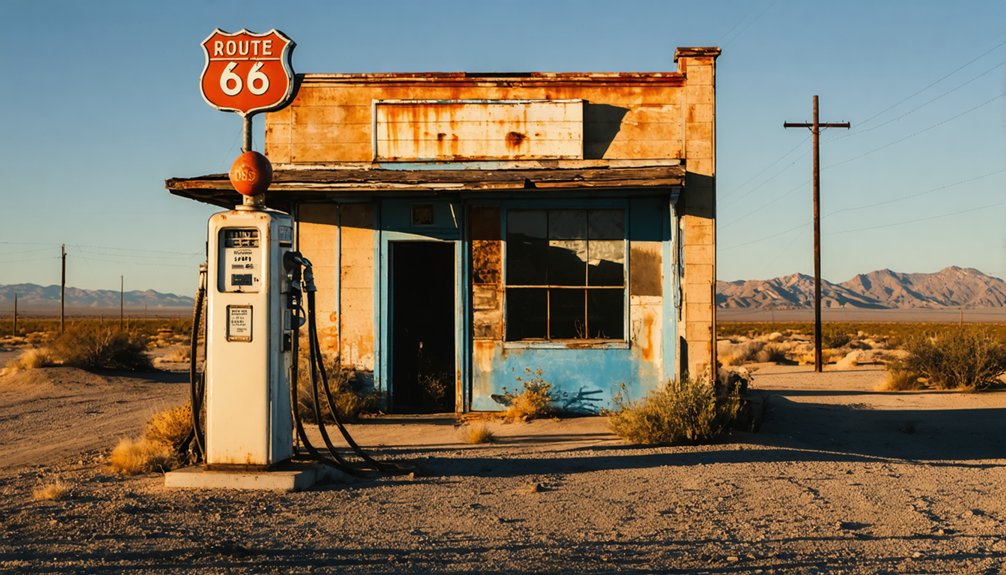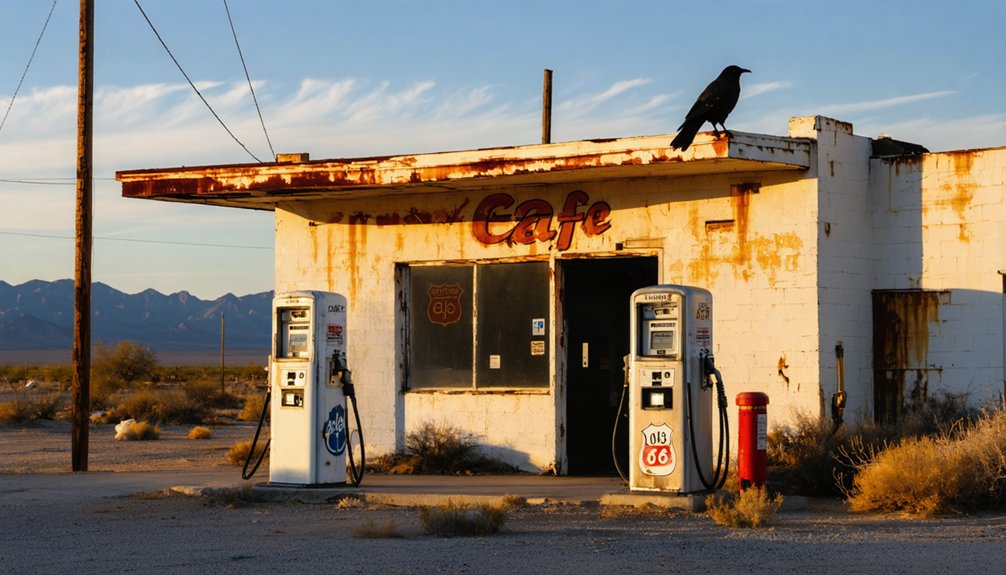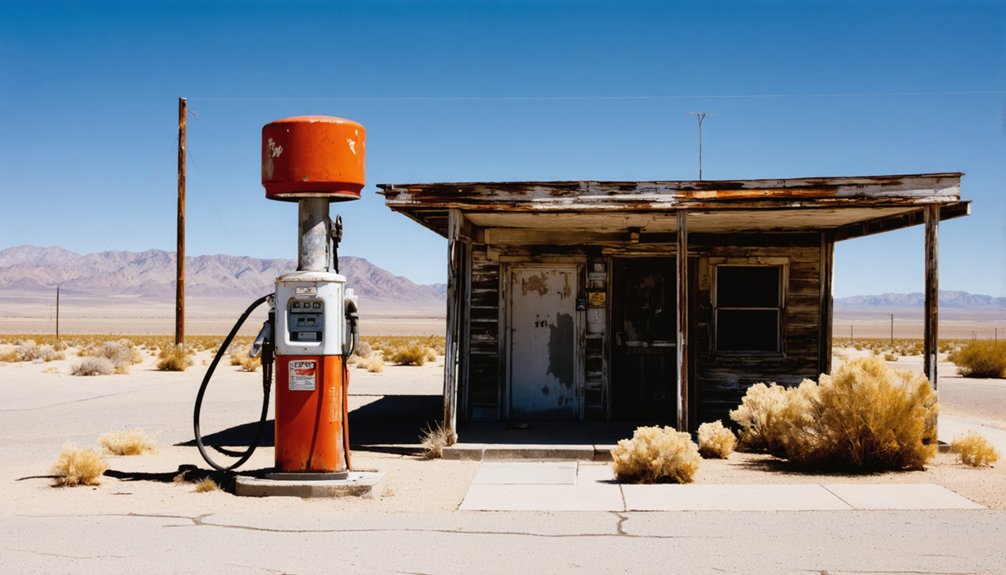Essex, California is a ghost town along historic Route 66 that thrived between the 1920s-1960s. You’ll find it in the Mojave Desert, where it once served as a crucial oasis for travelers with free water, a post office, diner, and gas station. When Interstate 40 opened in 1972, bypassing Essex completely, its population scattered and businesses closed. Today, weathered structures and the iconic Route 66 shield painted on the tarmac tell a story of desert abandonment.
Key Takeaways
- Essex began as a stop on the National Old Trails Highway, later becoming part of Route 66 in 1926.
- At its peak in the 1940s, Essex had approximately 55 residents with businesses including a diner, gas station, and post office.
- The town declined after Interstate 40 opened in 1972, bypassing Essex and causing businesses to close.
- Notable remnants include the stone post office building, weathered gas pumps, and a restored schoolhouse museum.
- Visitors should plan trips between October and April, bring supplies, and respect preservation efforts by not removing artifacts.
The Birth of a Desert Oasis: Essex’s Origin Story
As the National Old Trails Highway began to take shape in the early 1910s, Essex emerged as a small but strategic point along this ambitious transportation route connecting Los Angeles to New York.
You’d have found nothing but unpaved sandy stretches in 1915, with no services for weary travelers crossing the harsh Mojave Desert.
The town’s position evolved when the highway was realigned in the early 1920s, moving closer to the railroad tracks that were crucial to Essex’s survival. The community’s name was selected in alphabetical order among other stations established along the railroad. Much like other ghost town origins, Essex’s establishment was directly tied to transportation needs rather than mineral discoveries.
This dual access to historic transportation corridors cemented the settlement’s purpose as a rare desert development offering essential services.
When Route 66 incorporated Essex in 1926, its significance grew even further, creating a brief golden age before Interstate 40 eventually bypassed the town in the late 1960s.
Life Along the Mother Road: Essex During Route 66’s Heyday
During Route 66’s golden era, you’d find Essex transformed from an isolated desert outpost into an essential oasis for weary travelers crossing the Mojave.
The town’s strategic location on the 1931 realignment made it indispensable, offering free water from an Automobile Club well when other desert stops charged by the gallon. The well was conveniently positioned near the cafe, providing easy access for thirsty travelers. When Essex was bypassed by Interstate 40, the town gradually lost its significance as a popular stop.
With its diner, gas station, grocery store, and post office, Essex served approximately 55 residents while simultaneously meeting the needs of countless motorists traversing America’s most famous highway.
Roadside Prosperity Peak
The 1931 realignment of Route 66 transformed Essex from an obscure desert outpost into a vital waypoint along America’s most celebrated highway.
During the 1940s, when Essex reached its peak population of about 55 residents, you’d find a thriving community built around serving highway travelers.
The town’s unique advantage—free water in a region where most stops charged for it—made Essex a popular roadside attraction.
Travelers experienced genuine desert hospitality at establishments like the Wayside Cafe and Essex Shell Tire Shop. Bell’s Towing provided essential assistance to motorists stranded in the harsh Mojave climate.
This strategic location along both Route 66 and the Santa Fe Railway created perfect conditions for economic growth, unlike the coastal areas of Essex county which relied heavily on maritime industries and salt marshes for their economic development.
Local families operated businesses that served fellow residents and the steady stream of adventurers pursuing freedom on the open road.
Travelers’ Desert Oasis
Essex transformed into more than just a stopover point—it became a true desert oasis for weary Route 66 travelers crossing the unforgiving Mojave.
Unlike other stops where desert survival strategies meant paying for water, Essex offered a free drinking fountain installed by the Automobile Club of Southern California—a lifesaving amenity in the harsh environment.
Traveler anecdotes frequently highlighted four essential experiences that defined Essex:
- The relief of discovering free water after miles of desolate terrain
- The tight-knit community of just 55 residents who catered to passing motorists
- The strategic location 44 miles west of Needles, perfectly positioned for refueling
- The stark contrast of finding civilization amid the surrounding Kelso Dunes
This desert haven remained crucial until Interstate 40 eventually bypassed the town, contributing significantly to the town’s decline as traffic and commerce shifted away from Route 66. After the 1931 alignment change, Essex gained importance when the new route between Needles and Essex replaced Goffs as a primary stop.
Abandoned Dreams: How Interstate 40 Changed Essex Forever
Before the roar of Interstate 40 engines echoed through the Mojave Desert, tiny Essex stood as an important waystation for weary Route 66 travelers. The town provided gas, food, repairs, and most importantly, free water to those crossing the unforgiving landscape.
Everything changed in 1972 when I-40 was completed, bypassing Essex entirely. The economic impact was immediate and devastating. Businesses that had thrived on transient traffic shuttered their doors as travelers zoomed past on the new high-speed freeway miles away.
Progress showed no mercy to Essex, leaving its economy crumbling in the dust of I-40’s roaring traffic.
The cultural shift was equally profound. A once-vibrant community of about 55 residents scattered, leaving behind abandoned buildings and fading memories. This transformation was part of a larger pattern that followed the US 66 truncation which officially occurred when I-40 was completed in the region. Like many communities along historic highways, Essex represents the historical interchange of transportation routes that dramatically altered local landscapes.
The famous roadside rock art tradition dwindled with the traffic. Essex transformed from a vital desert lifeline into a haunting reminder of how quickly progress can leave a place behind.
What Remains: A Walking Tour of Essex’s Ghost Town Ruins
As you explore Essex’s ghostly remains, the abandoned post office stands as a symbol of the town’s former energy, its faded signage and empty interior telling stories of bustling community activity.
Nearby, weathered gas pumps rise from cracked concrete, their rusted frames and frozen dials marking where travelers once refueled along Route 66.
These silent sentinels of commerce represent key stops on the walking tour, offering tangible connections to Essex’s heyday before Interstate 40 diverted the lifeblood of passing traffic. Visitors can extend their ghost town experience by visiting the beautifully restored early 1900s schoolhouse that now serves as a museum showcasing the area’s rich desert history.
Abandoned Post Office
The stone post office building stands as one of the most iconic remnants of Essex’s former energy. This abandoned architecture once served as the community’s essential mail hub, operated by local families like Hank and Elva until postal services were rerouted through Needles.
The weathered structure at the southeast corner of US 66 and Sunflower Springs Road chronicles Essex’s postal history through its silent deterioration.
As you explore this historical landmark, you’ll notice:
- The intact gabled roof and stone exterior that’s withstood decades of desert elements
- Original windows and door frames, now sealed against public entry
- The famous Route 66 shield painted on the tarmac directly in front
- Neighboring ruins of the once-bustling Wayside Market and service station complex
Weathered Gas Pumps
Rusting relics of a bygone era, the weathered gas pumps of Essex stand as silent sentinels to the town’s once-vital role along Route 66.
As you explore the ghost town, you’ll find these gas station remnants a couple miles east of the main area, surrounded by desert debris and crumbling stonework.
These pumps tell a weathered history of Essex’s importance to desert travelers. During the Depression, the adjacent Automobile Club well provided rare “free water” when travelers typically paid 10 cents per gallon elsewhere.
Cars frequently overheated in the Mojave’s punishing climate, making Essex an essential stop.
After Interstate 40 bypassed the town, these once-crucial services became obsolete.
Today, only corroded metal, stone foundations, and scattered mechanical parts remain—testament to America’s shifting transportation landscape and the freedom of the open road.
The Flat Tire Legend: Separating Fact From Fiction

Many visitors to Essex have heard the enchanting tale of its founding: a stranded motorist with a flat tire who inadvertently established a desert oasis on Route 66.
This ghost town myth persists despite the absence of primary historical evidence supporting it.
The reality is more practical than romantic. Essex developed organically to meet Route 66 travelers’ needs, not from a single desert survival incident.
While the flat tire story captures your imagination, documented history tells a different tale.
Four reasons this legend endures:
- It dramatizes the perils of early Mojave Desert travel
- It simplifies complex historical development into a memorable narrative
- It reinforces the romance of Route 66’s forgotten places
- It attracts curious travelers seeking connection to America’s highway heritage
Essex and Its Desert Neighbors: A Route 66 Ghost Town Corridor
As you drive the forgotten stretches of Route 66 between Needles and Barstow, you’ll find Essex within a remarkable corridor of ghost towns including Goffs, Fenner, Chambless, Danby, and Summit.
These isolated desert outposts once served as crucial water stops and service centers for travelers crossing the harsh Mojave landscape, with Essex prominently offering free water from a well dug by the Automobile Club of Southern California.
The fates of these towns became intertwined when Interstate 40’s construction in the 1970s diverted traffic away, transforming a once-bustling highway into a necklace of abandoned buildings and fading memories.
Desert Isolation Shapes Destiny
The unforgiving Mojave Desert landscape played a decisive role in shaping Essex and its neighboring settlements, which originally emerged as essential water stops for steam engines in the late 19th century.
Desert survival required extraordinary self-reliance, yet this isolation ultimately became these towns’ greatest vulnerability.
The harsh environment limited growth and diversification, while geographic remoteness restricted access to vital resources.
Historical resilience emerged from necessity but couldn’t overcome shifting transportation patterns.
Four emotional impacts of desert isolation:
- Pride in frontier-like independence against harsh odds
- Vulnerability when economic lifelines were severed
- Abandonment as populations dwindled after I-40’s construction
- Loss of community as families sought opportunities elsewhere
Without nearby urban centers to offset downturns, Essex’s fate was sealed by its very remoteness.
Route 66’s Forgotten Outposts
Stretching like forgotten sentinels across the Mojave Desert, a series of alphabetically named outposts once served as essential lifelines along Route 66 and the Atlantic and Pacific Railroad.
Engineer Lewis Kingman’s alphabetical naming convention—Amboy, Bristol, Cadiz, Danby, Essex, Fenner, Goffs—created a distinctive desert corridor of historical significance.
These towns evolved from railroad water stops into highway service centers when Route 66 incorporated the old National Old Trails Road.
Essex, founded in 1883, flourished by the 1940s with amenities catering to desert travelers, including free water from a well installed by the Automobile Club.
What appears as a desert mirage today was once vibrant with commerce and community life, complete with a school that operated until the 1970s when Interstate 40’s opening diverted traffic and triggered their collective abandonment.
Connecting Ghost Town Dots
Connected by both railroad ties and asphalt ribbons, Essex forms part of an evocative ghost town corridor stretching across California’s eastern Mojave Desert.
Following the alphabetically-named pattern established by railroad engineer Lewis Kingman, these settlements rose and fell together with the fortunes of Route 66.
The ghost town connections that define this corridor include:
- Amboy – home to the iconic Roy’s Café, now standing as a symbol of mid-century roadside Americana
- Goffs – featuring a preserved 1914 schoolhouse that serves as a museum of railroad legacy
- Fenner – once vibrant but now virtually vanished from the landscape
- Danby – another alphabetical outpost that has surrendered completely to the desert
These abandoned communities collectively tell the story of transportation’s evolution and America’s changing travel patterns.
Preservation Challenges in the Mojave’s Forgotten Communities
Throughout the Mojave Desert, ghost towns like Essex face mounting preservation challenges that threaten to erase these historical landmarks from America’s landscape.
The harsh desert climate accelerates structural deterioration, with flash floods and windstorms regularly damaging remaining buildings and archaeological sites.
Preservation funding remains woefully inadequate, with projects like the Kelso Depot requiring $24,000 just for basic maintenance.
The complete restoration of ghost towns can cost upward of $900,000, while limited community engagement makes local stewardship nearly impossible as populations dwindle.
Meanwhile, development pressures from renewable energy projects compete for the same lands.
The infrastructure continues to crumble—water systems fail, roads decay, and historic structures collapse.
Without coordinated action between government agencies, preservation groups, and remaining residents, these forgotten communities will vanish into the desert sands.
Photography Guide: Capturing Essex’s Haunting Beauty

Every ghost town holds unique photographic opportunities, but Essex presents distinctive challenges and rewards for photographers seeking to document its haunting desert beauty. The abandoned architecture tells stories best when shot in early morning or late afternoon light, when shadows reveal texture and decay.
Bring a tripod for low-light interior shots and wide-angle lenses to capture the town’s isolation against expansive Mojave landscapes.
Stabilize your compositions and expand your perspective to reveal Essex’s desolation amid the vast desert expanse.
To evoke powerful emotional responses in your images:
- Frame weathered buildings against the harsh desert backdrop to highlight human impermanence
- Contrast Route 66 memorabilia with desert encroachment to symbolize fading Americana
- Utilize black and white to emphasize textural details and timeless abandonment
- Capture reflections in remaining windows to suggest ghostly presences of the past
Practical Tips for Visiting Essex and Nearby Ghost Towns
Planning a successful visit to Essex and neighboring ghost towns requires careful preparation due to their remote Mojave Desert locations and limited services.
Time your exploration between October and April to avoid dangerous summer heat exceeding 100°F. Fill your gas tank in Needles or Ludlow, as Essex offers no commercial services.
Bring ample water, snacks, sun protection, and a high-clearance vehicle for unpaved sections. Visit Goffs (Friday-Sunday, 9am-4pm) to see the restored 1914 schoolhouse and outdoor mining museum—key Essex attractions worth documenting.
When exploring, respect ghost town preservation efforts by never removing artifacts or disturbing structures.
Check weather forecasts and road conditions before departing, as flash floods can make desert roads impassable. Always share your itinerary with someone, as cell service is unreliable throughout the area.
Essex Through the Seasons: Best Times to Experience the Ghost Town

The desert climate of Essex creates distinct seasonal experiences that dramatically impact your ghost town visit. For best seasonal exploration, consider how each period shapes visitor experiences across the abandoned landscape.
- Spring (65-75°F) offers balanced daylight, moderate crowds, and desert flora blooms that create natural color contrast for photography.
- Summer (95°F+) brings extended daylight but harsh conditions—plan early morning or late afternoon exploration when wildlife activity increases.
- Fall (60-80°F) represents peak season with golden hour lighting, cooler temperatures, and maximum visitor services—perfect for photography and longer visits.
- Winter (below 40°F) delivers dramatic low-angle sunlight and minimal crowds, though limited wildlife and occasional road closures may affect accessibility.
Frequently Asked Questions
Are There Any Paranormal or Haunting Reports From Essex?
Unlike 44% of famous ghost towns, Essex has no documented ghost sightings. You’ll find no record of paranormal investigations there—the town’s eerie atmosphere comes from isolation rather than supernatural presence.
What Happened to Essex’s Original Residents After the Town’s Decline?
You’ll find Essex’s original residents scattered to nearby towns after economic challenges forced their departure. Their displacement stories follow the classic pattern of rural exodus after Interstate 40 bypassed their livelihood sources.
Is Camping Allowed Near or Within Essex’s Ghost Town Boundaries?
No, you can’t camp within Essex’s boundaries. Camping regulations prohibit pitching tents in the ghost town itself. Seek sanctioned shelter at several surrounding campgrounds where permits are properly processed.
What Natural Hazards Should Visitors Be Aware of in Essex?
You’ll face dust storms, toxic air, extreme heat, earthquake risks, flash floods, unstable structures, and limited emergency services. Desert terrain contains venomous wildlife, while geothermal activity releases hazardous gases near Essex.
Did Any Films or Television Shows Feature Essex as a Location?
While Essex itself hasn’t been featured prominently in major film locations or television episodes, nearby spots like Roy’s Motel and Café in Amboy have appeared in various productions and commercials.
References
- https://whimsysoul.com/must-see-california-ghost-towns-explore-forgotten-histories/
- https://www.legendsofamerica.com/ca-mojaveghosttowns/
- http://patricktillett.blogspot.com/2013/08/essex-california-route-66-ghost-town.html
- https://www.sfgate.com/travel/slideshow/Take-a-road-trip-to-see-these-California-ghost-184071.php
- https://1dustytrack.blogspot.com/2013/05/route-66-essex-very-unpleasant-encounter.html
- https://www.theroute-66.com/essex.html
- https://digital-desert.com/route-66/essex/
- https://www.geotab.com/ghost-towns/
- https://pinintheatlas.com/travel-blogs/goffs-ghost-town/
- http://cali49.com/mojave/2016/10/18/essex-cal-route-66



